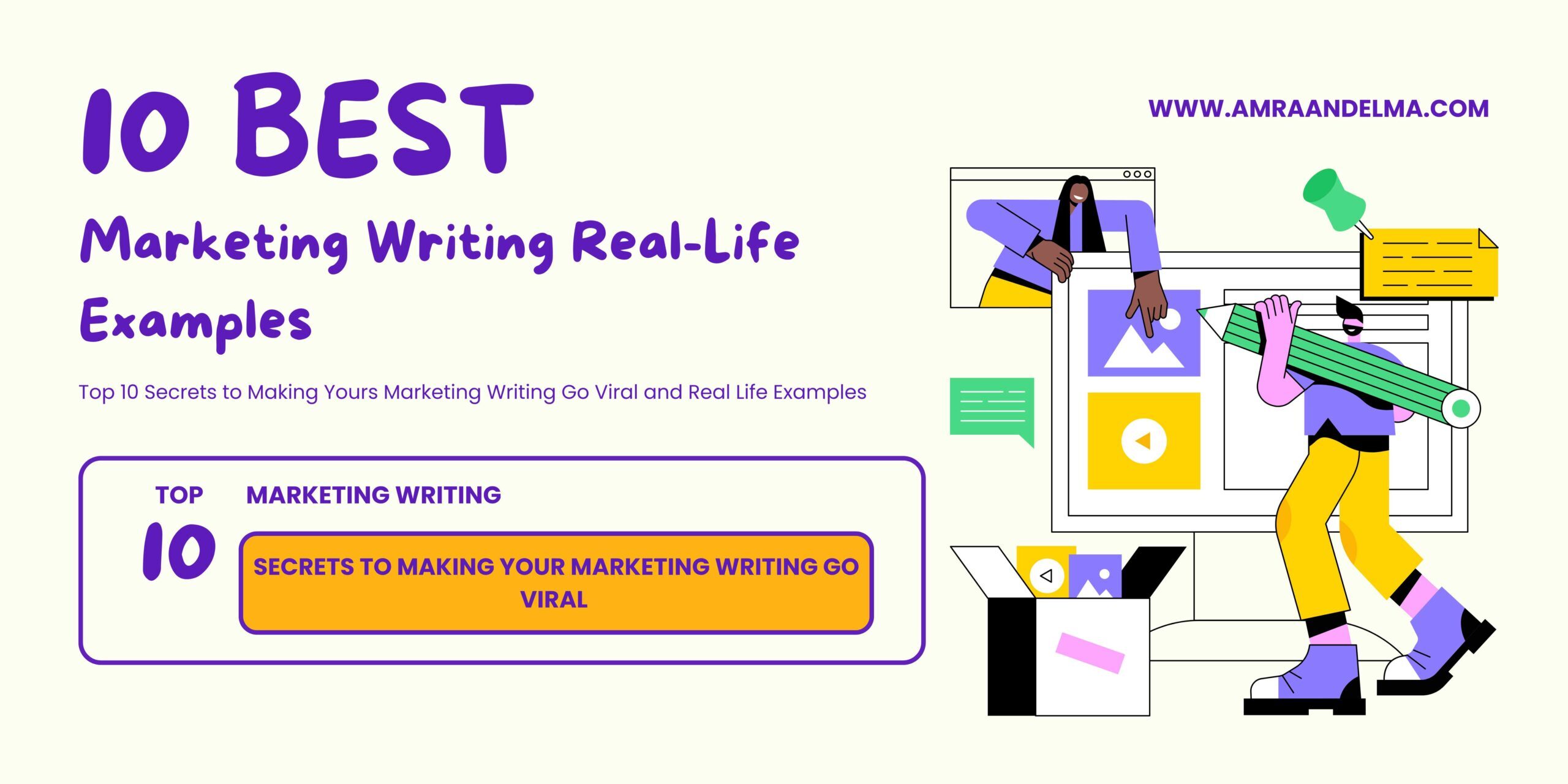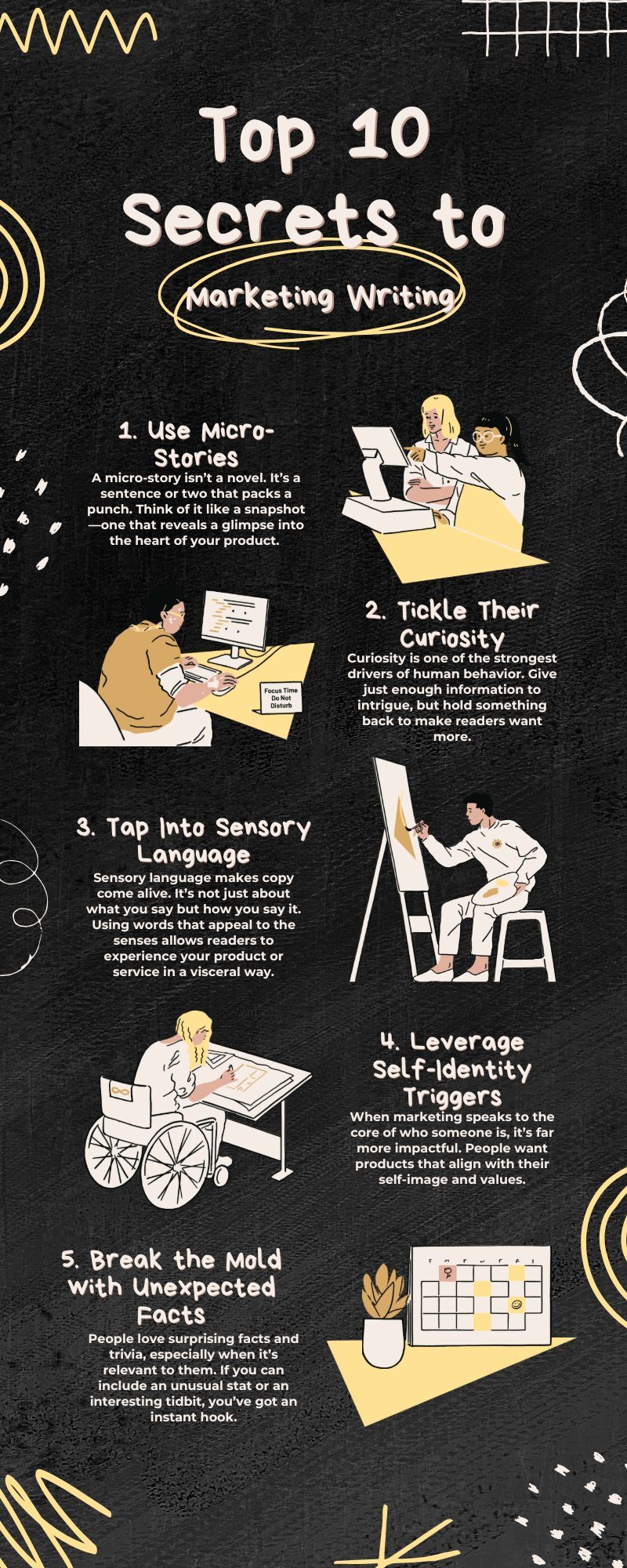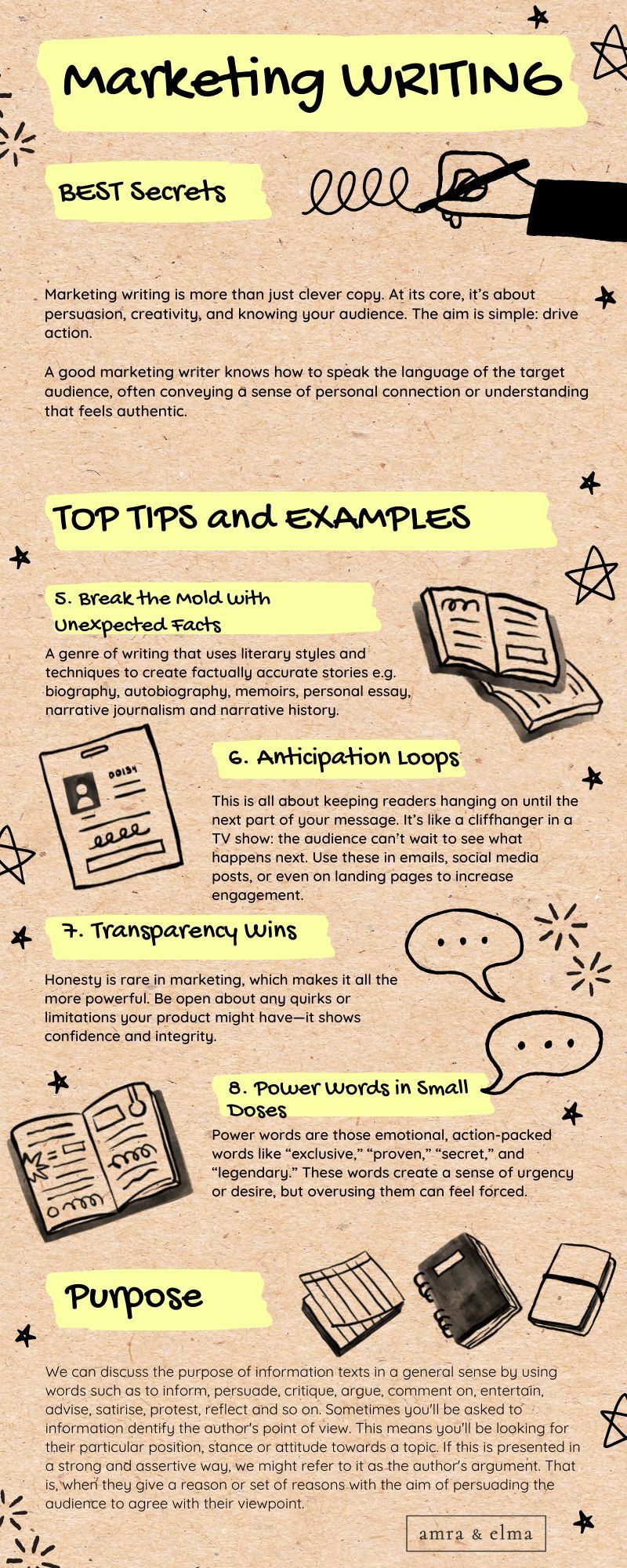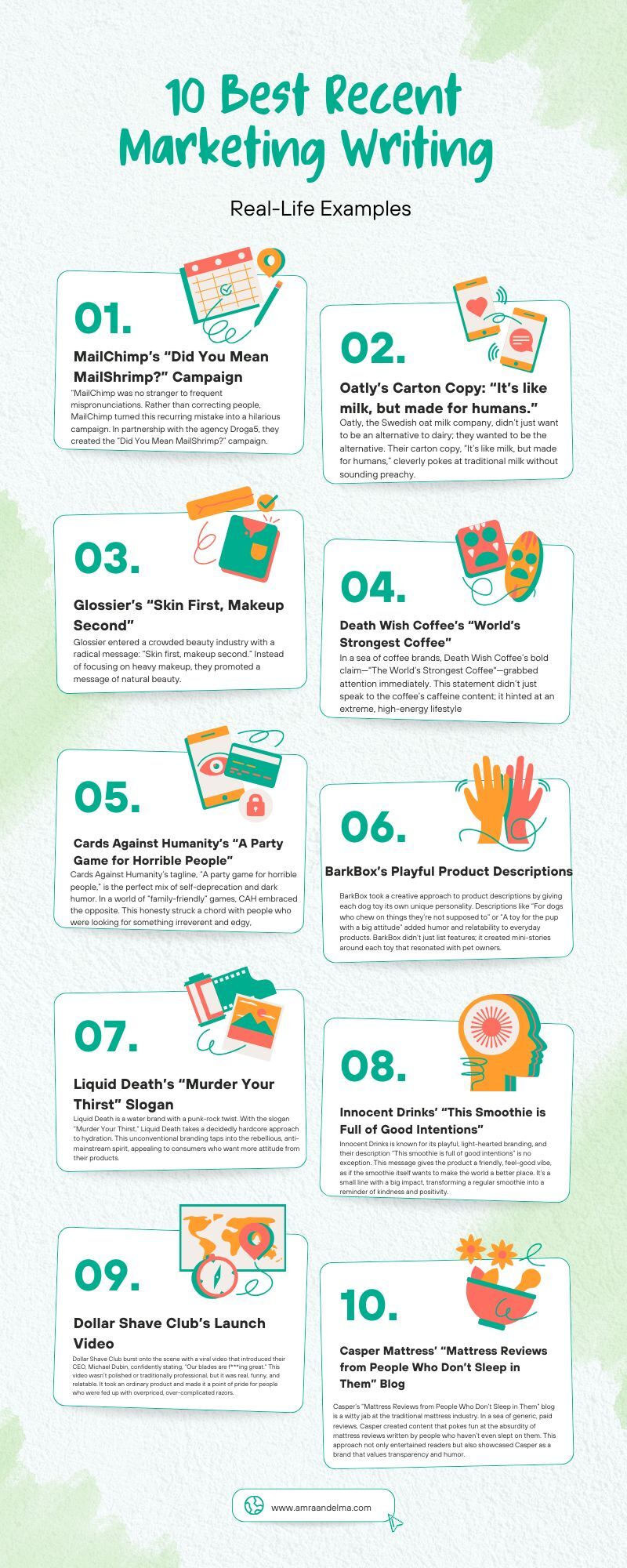
08 Nov 10 RECENT BEST MARKETING WRITING EXAMPLES
Marketing writing isn’t just clever words strung together on a page. It’s the art of making people feel, igniting curiosity, excitement, and trust—all within just a few lines. Imagine you’re at a crowded cocktail party, every brand competing for attention. Some blend into the background, a murmur in the mix. Then there’s the marketing writing that stands out: that one guest who has everyone’s attention, who can spin a story so vivid that people hang on every word, even after they’ve moved on. That’s the magic of great marketing writing—it lingers, it resonates, it makes you lean in just a bit closer.
But here’s the kicker: not all marketing writing works this way. For every ad that catches fire, dozens fizzle out; for every brand post that goes viral, there’s a handful that barely make a ripple. Why is that? What’s the secret ingredient that turns “just okay” copy into the kind of words that can’t be ignored?
It’s not always what you think, there are some obvious tactics—snappy headlines, clever taglines, maybe even a bit of humor. But the real magic? It’s often hidden in the details, in the subtle art of knowing exactly what the reader wants, sometimes before they even know it themselves. Great marketing writing doesn’t just throw out catchy phrases; it dives deeper, anticipating questions, addressing doubts, and creating a connection that feels personal. It’s as if the words on the screen or page are reaching out, speaking directly to you.
Over the years, I’ve seen what separates the viral hits from the flops. I’ve watched campaigns explode, ads resonate far beyond what anyone expected, and seen some brands become household names overnight—all because of a few well-crafted words. After 25 years of living and breathing this world, I can tell you that great marketing writing often hinges on a few secrets, little-known strategies that only the best seem to master. These aren’t your standard “how-to” tips; these are tried-and-true techniques that give copy that irresistible edge, the kind that makes readers lean in and say, “Tell me more.”
In the following sections, we’ll dig into these strategies, exploring what makes marketing writing tick and what it takes to make yours go viral. We’ll break down ten of the top strategies I’ve gathered over a career that’s spanned shifts in media, tech, and audience preferences, offering insights into why certain words and approaches work while others fall flat. These tips aren’t just theory; they’re the distillation of years of real-world experience and practice.
And, of course, the real proof lies in action. We’re going beyond just talking about strategies and diving into some of the best recent examples of marketing writing done right. These are campaigns and messages that didn’t just grab attention; they sparked genuine connection, inspired action, and became case studies in the power of words to make people feel and remember. These aren’t just good examples—they’re unforgettable, and they hold lessons for any writer or brand looking to break through the noise.
So, get ready to go beyond the surface and explore what makes truly captivating marketing writing.
10 BEST MARKETING WRITING EXAMPLES FROM RECENT TIMES
1. MailChimp’s “Did You Mean MailShrimp?” Campaign
2. Oatly’s Carton Copy: “It’s like milk, but made for humans.”
3. Glossier’s “Skin First, Makeup Second”
4. Death Wish Coffee’s “World’s Strongest Coffee”
5. Cards Against Humanity’s “A Party Game for Horrible People”
6. BarkBox’s Playful Product Descriptions
7. Liquid Death’s “Murder Your Thirst” Slogan
8. Innocent Drinks’ “This Smoothie is Full of Good Intentions”
9. Dollar Shave Club’s Launch Video
10. Casper Mattress’ “Mattress Reviews from People Who Don’t Sleep in Them” Blog
2. What is Marketing Writing and Top 10 Secrets to Making Yours Go Viral
Marketing Writing Defined
Marketing writing is more than just clever copy. At its core, it’s about persuasion, creativity, and knowing your audience. The aim is simple: drive action. Whether you’re crafting an ad, a social media post, an email, or a landing page, every word should be chosen to resonate, inspire, or intrigue. Effective marketing writing builds bridges, turning a passive reader into an active participant. A good marketing writer knows how to speak the language of the target audience, often conveying a sense of personal connection or understanding that feels authentic.
So how do we make our marketing writing go viral? Viral marketing writing is crafted to be shared, not because you ask for shares but because it speaks to something fundamental in the audience—it entertains, it educates, or it makes them feel understood. Let’s dive into the ten strategies I’ve found to have the most impact.
Top 10 Strategies to Make Your Marketing Writing Go Viral
- Use Micro-Stories
According to EssayLtd, a gold standard and “best essay writing service” as described by the reviews, a “micro-story isn’t a novel.” It’s a sentence or two that packs a punch. Think of it like a snapshot—one that reveals a glimpse into the heart of your product. Instead of saying “Our jeans are high-quality,” try “These jeans are hand-stitched in Italy, inspired by a 100-year-old family recipe for the perfect fit.” Now you’re not just selling jeans; you’re selling a legacy, tradition, and artisanal craftsmanship.
- Tip: Try starting your copy with a “Once upon a time” approach—set the scene, create a visual, and use just enough words to draw readers in without giving it all away.
- Example: For a bakery, instead of “Fresh bread baked daily,” go for, “Every morning at 5 a.m., our bakers arrive to mix, knead, and bake—the smell alone could bring tears to your eyes.”
- Tickle Their Curiosity
Curiosity is one of the strongest drivers of human behavior. Give just enough information to intrigue, but hold something back to make readers want more.
- Tip: Instead of saying “Our product is great,” try a phrase like, “Why our product isn’t for everyone…” This counterintuitive approach makes people stop and ask, “Why not?”
- Example: For a productivity app, rather than a generic pitch, use: “Why 5,000 entrepreneurs are raving about this tool, but some couldn’t handle it…”
- Tap Into Sensory Language
Sensory language makes copy come alive. It’s not just about what you say but how you say it. Using words that appeal to the senses allows readers to experience your product or service in a visceral way.
- Tip: Use words that evoke textures, colors, sounds, tastes, or smells. For instance, instead of “comfortable pillow,” try “as soft as a summer breeze.”
- Example: For a perfume brand, instead of “a floral fragrance,” use “Imagine walking through a spring garden at dusk, the air thick with the scent of blooming jasmine.”
- Leverage Self-Identity Triggers
When we say “self identity triggers” we mean marketing language that focuses on core of who someone is, it’s far more impactful. People want products that align with their self-image and values.
- Tip: Describe your audience in ways that resonate with how they see themselves. For example, “For the bold dreamers” or “Perfect for those who live life on their terms.”
- Example: For a travel agency targeting adventure seekers, you could say, “For the ones who collect memories, not things.”
- Break the Mold with Unexpected Facts
People love surprising facts and trivia, especially when it’s relevant to them. If you can include an unusual stat or an interesting tidbit, you’ve got an instant hook.
- Tip: Look for little-known statistics that challenge conventional wisdom or expectations. For example, “Did you know 80% of people wear the wrong shoe size?”
- Example: For a hydration product, you could use, “Did you know that by the time you feel thirsty, you’re already dehydrated? Here’s how to hydrate smarter…”

- Anticipation Loops
According to EssayWriteCheap, a popular destination for writing assistance also known by their slogan as “write my essay” “it is all about keeping readers hanging on until the next part of your message.” It’s like a cliffhanger in a TV show: the audience can’t wait to see what happens next. Use these in emails, social media posts, or even on landing pages to increase engagement.
- Tip: Split your message into parts that build on one another, like “Here’s the first step to mastering X, but wait until you see the third…”
- Example: For a fitness app email campaign: “Today’s tip: the one move that activates 90% of your core. Tomorrow? The ultimate stretch for instant relief…”
- Transparency Wins
Honesty is rare in marketing, which makes it all the more powerful. Be open about any quirks or limitations your product might have—it shows confidence and integrity.
- Tip: Share the “cons” of your product in a lighthearted, matter-of-fact way, which builds trust and relatability.
- Example: For an electric car brand: “Our charging network isn’t as big as we’d like yet, but we’re growing every month. And once you’re behind the wheel, it’s worth the wait.”
- Power Words in Small Doses
Power words are those emotional, action-packed words like “exclusive,” “proven,” “secret,” and “legendary.” These words create a sense of urgency or desire, but overusing them can feel forced.
- Tip: Use power words in headlines, subheadings, or CTAs, where they’ll have the most impact. Sprinkle them in, don’t saturate.
- Example: For an online course: “Unlock the secrets to a thriving freelance career in just five weeks.” Notice how “unlock” and “secrets” instantly add intrigue.
- Address Common Objections Head-On
Every buyer has doubts. Addressing these concerns before they’re even voiced shows empathy and builds credibility.
- Tip: Use this tactic to provide a no-risk guarantee, return policy, or a special benefit for new users.
- Example: For a mattress brand: “Not sure if it’s for you? Sleep on it for 100 nights, risk-free. If you’re not in love, we’ll pick it up and give you a full refund.”
- The “Less-Than-Perfect” Strategy
Acknowledging imperfections in your product can make you more trustworthy. Being realistic about your product’s strengths and limitations shows you value honesty over fluff.
- Tip: Use this when you know your product might not suit every scenario. Customers appreciate it, and it reduces the likelihood of negative surprises.
- Example: For a jacket: “Our waterproof jacket keeps you dry in the heaviest storms, but it’s not insulated, so wear a layer in winter.”

10 Best Recent Marketing Writing Examples from Real-Life
In the first section, we explored what makes marketing writing compelling and the top strategies to make your own work stand out. From using micro-stories to capturing the senses and building anticipation, these techniques turn simple words into experiences that resonate with readers. But theory is only part of the story—real impact comes from seeing these strategies in action.
Here, we’ll dive into ten real-life examples of recent marketing writing that didn’t just follow these principles—they brought them to life. Each example showcases a unique brand approach, blending humor, boldness, authenticity, and storytelling to create unforgettable messages. These brands didn’t just grab attention; they created connections, sparked conversations, and, in some cases, reshaped entire markets. Let’s take a closer look at how these companies turned words into viral campaigns, transforming simple concepts into moments people couldn’t wait to share.
1. MailChimp’s “Did You Mean MailShrimp?” Campaign
MailChimp is a marketing platform known for helping businesses send and track their emails. But with a quirky name like “MailChimp,” the company was no stranger to frequent mispronunciations. Rather than correcting people, MailChimp turned this recurring mistake into a hilarious campaign. In partnership with the agency Droga5, they created the “Did You Mean MailShrimp?” campaign, launching a series of ads with intentionally misheard names like “MailShrimp,” “FailChimp,” and “MaleCrimp.” Each variation was more absurd than the last, from products that made no sense to even more ridiculous brand names.
-
- Why It Worked: MailChimp transformed a perceived flaw into a charming, memorable asset. By leaning into the joke, they created a sense of community and relatability with their audience, making MailChimp the brand that doesn’t take itself too seriously.
- Tip: Embrace your quirks. Sometimes, what seems like a flaw is the very thing that makes your brand relatable. Owning up to these quirks can turn mistakes into memorable brand moments.
- Story Expansion: Imagine MailChimp as a friend who constantly gets miscalled but laughs it off and owns every nickname. This self-deprecating humor won MailChimp a place in people’s hearts, making it not just a tool but a brand they felt they could connect with on a human level.

2. Oatly’s Carton Copy: “It’s like milk, but made for humans.”
Oatly, the Swedish oat milk company, didn’t just want to be an alternative to dairy; they wanted to be the alternative. Their carton copy, “It’s like milk, but made for humans,” cleverly pokes at traditional milk without sounding preachy. It’s an invitation to rethink dairy in a friendly, humorous way. Oatly’s line sparked conversation and captured the attention of plant-based enthusiasts as well as dairy drinkers.
-
- Why It Worked: The line is both bold and relatable, striking a chord with consumers who already question dairy or are open to plant-based alternatives. The humor is disarming and invites consumers to join the “Oatly club” without feeling like they’re being lectured.
- Tip: Don’t be afraid to poke fun at established norms. If your product disrupts an industry, make it clear without being confrontational. A little humor can go a long way in breaking down resistance.
- Story Expansion: Oatly’s carton copy is like the friend who brings a fresh perspective to the dinner table, casually saying, “Why do we do it that way?” It’s the question you hadn’t thought to ask, but once it’s out there, you can’t ignore it. Oatly became more than a brand; it became a nudge towards conscious consumerism, delivered with a smile.
3. Glossier’s “Skin First, Makeup Second”
Glossier entered a crowded beauty industry with a radical message: “Skin first, makeup second.” Instead of focusing on heavy makeup, they promoted a message of natural beauty and skin message of self-acceptance in an industry often focused on covering up flaws. Glossier’s “Skin first, makeup second” appealed to a new generation that values authenticity, transparency, and wellness.
- Why It Worked: Glossier’s slogan turned the traditional beauty narrative on its head by emphasizing that beauty starts with healthy skin, not layers of makeup. This message resonated with millennials and Gen Z, who appreciate a brand that values their natural beauty.
- Tip: Align your brand with a cause or value that resonates deeply with your audience. Glossier’s focus on natural beauty created a loyal community that felt seen and valued.
- Story Expansion: Glossier feels like that friend who reminds you that you’re beautiful just as you are. Their message wasn’t about selling makeup; it was about instilling confidence. The brand became a movement, encouraging people to celebrate their unique beauty and challenging the notion that makeup is a necessity.
4. Death Wish Coffee’s “World’s Strongest Coffee”
In a sea of coffee brands, Death Wish Coffee’s bold claim—”The World’s Strongest Coffee“—grabbed attention immediately. This statement didn’t just speak to the coffee’s caffeine content; it hinted at an extreme, high-energy lifestyle that resonated with people who wanted a product as intense as they are. Death Wish created a brand identity that’s unapologetic, edgy, and intense.
- Why It Worked: The promise of extreme strength isn’t just a sales pitch—it’s a challenge, a dare for those who want the most powerful cup of coffee they can get. This bold statement appeals to hardcore coffee lovers and creates a brand that’s impossible to forget.
- Tip: If you have a unique selling point, make it the star of your messaging. Don’t water it down—own it with confidence, and let it speak to those who want exactly what you’re offering.
- Story Expansion: Death Wish Coffee is like that friend who’s always pushing the limits, the one who convinces you to go skydiving at sunrise. It’s a brand that speaks directly to people who live life on the edge, creating a cult-like following among those who crave more than just a regular coffee.
6. BarkBox’s Playful Product Descriptions
BarkBox took a creative approach to product descriptions by giving each dog toy its own unique personality. Descriptions like “For dogs who chew on things they’re not supposed to” or “A toy for the pup with a big attitude” added humor and relatability to everyday products. BarkBox didn’t just list features; it created mini-stories around each toy that resonated with pet owners.
- Why It Worked: BarkBox’s descriptions make customers feel like they’re choosing something special and personal for their pet, adding an emotional connection to each purchase.
- Tip: Give each product a distinct voice or backstory to make it feel unique. This can create an emotional connection and increase the perceived value.
- Story Expansion: BarkBox is that friend who knows exactly what your dog needs—a toy that not only entertains but matches your pup’s quirky personality. By infusing humor into their descriptions, BarkBox turns a simple transaction into an experience, strengthening customer loyalty.
7. Liquid Death’s “Murder Your Thirst” Slogan
Liquid Death is a water brand with a punk-rock twist. With the slogan “Murder Your Thirst,” Liquid Death takes a decidedly hardcore approach to hydration. This unconventional branding taps into the rebellious, anti-mainstream spirit, appealing to consumers who want more attitude from their products.
- Why It Worked: By branding water as something edgy, Liquid Death turned a mundane product into something intriguing and appealing to a non-conformist audience.
- Tip: If you’re in a crowded market, use unexpected language or imagery to stand out. Don’t be afraid to break conventions if it aligns with your brand’s personality.
- Story Expansion: Liquid Death feels like the friend who’s always pushing boundaries, who can make even the simplest things feel thrilling. “Murder Your Thirst” isn’t just a slogan—it’s an invitation to join a community that values boldness over blandness. The brand gives water a personality that resonates with those who don’t want to blend in.
8. Innocent Drinks’ “This Smoothie is Full of Good Intentions”
Innocent Drinks is known for its playful, light-hearted branding, and their description “This smoothie is full of good intentions” is no exception. This message gives the product a friendly, feel-good vibe, as if the smoothie itself wants to make the world a better place. It’s a small line with a big impact, transforming a regular smoothie into a reminder of kindness and positivity.
- Why It Worked: Innocent Drinks uses language that personifies their products, making customers feel like they’re choosing something wholesome and uplifting.
- Tip: Use language that reflects the values you want to project. Innocent’s playful and kind tone creates a bond with customers who share similar values.
- Story Expansion: Innocent Drinks is like that friend who’s always spreading positivity and encouraging you to do the same. Their messaging isn’t just about the smoothie; it’s about creating a moment of kindness. This small act of connecting with customers’ values makes Innocent a brand people want to support.
9. Dollar Shave Club’s Launch Video
Dollar Shave Club burst onto the scene with a viral video that introduced their CEO, Michael Dubin, confidently stating, “Our blades are f***ing great.” This video wasn’t polished or traditionally professional, but it was real, funny, and relatable. It took an ordinary product and made it a point of pride for people who were fed up with overpriced, over-complicated razors.
- Why It Worked: The ad didn’t just sell razors; it resonated with people frustrated by the industry’s inflated prices. Dollar Shave Club’s down-to-earth message positioned them as the cool underdog.
- Tip: Authenticity and humor can go a long way. Don’t be afraid to take a bold, unconventional approach if it’s true to your brand’s personality.
- Story Expansion: Dollar Shave Club is like that friend who cuts through the nonsense and tells it like it is. The launch video didn’t just introduce a product; it introduced a new way of thinking about personal care—straightforward, no frills, and refreshingly honest.
10. Casper Mattress’ “Mattress Reviews from People Who Don’t Sleep in Them” Blog
Casper’s “Mattress Reviews from People Who Don’t Sleep in Them” blog is a witty jab at the traditional mattress industry. In a sea of generic, paid reviews, Casper created content that pokes fun at the absurdity of mattress reviews written by people who haven’t even slept on them. This approach not only entertained readers but also showcased Casper as a brand that values transparency and humor.
- Why It Worked: Casper’s honesty about the ridiculousness of traditional mattress reviews sets them apart as a brand with integrity and a sense of humor.
- Tip: Be transparent and humorous about industry quirks. If you can poke fun at something that frustrates consumers, you build instant credibility.
- Story Expansion: Casper feels like that friend who calls out the obvious but unspoken flaws in a system. By highlighting the weirdness of traditional reviews, they positioned themselves as the brand that gets it, building trust with consumers seeking an authentic product experience.


5. Cards Against Humanity’s “A Party Game for Horrible People”
Cards Against Humanity’s tagline, “A party game for horrible people,” is the perfect mix of self-deprecation and dark humor. In a world of “family-friendly” games, CAH embraced the opposite. This honesty struck a chord with people who were looking for something irreverent and edgy, making it the go-to choice for those seeking a no-holds-barred game night.